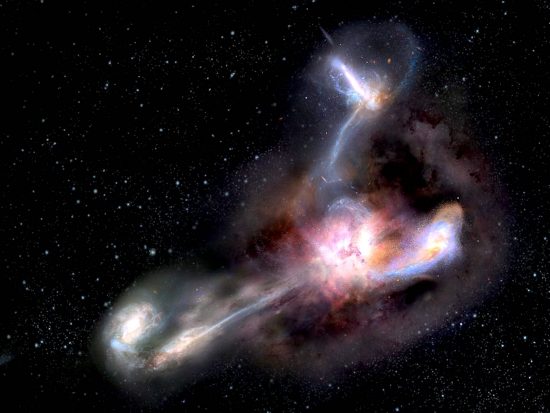
February 18, 2020
Electric filaments energize galaxies.
“A colour is a physical object as soon as we consider its dependence, for instance, upon its luminous source, upon other colours, upon temperatures, upon spaces, and so forth.”
— Ernst Mach
A recent press release talks about cosmic filaments connecting vast galactic structures. The “most luminous galaxy” ever detected, W2246-0526, appears to be drawing material from three other galaxies.
Information provided by the Atacama Large Millimeter/submillimeter Array (ALMA) suggests that the companion galaxies are “feeding” enough dust and gas into W2246-0526 that it will sustain its star-forming processes for hundreds of millions of years. The galaxy’s extreme luminosity is said to be caused by a supermassive black hole that absorbs the streamers, energizing a disk of glowing plasma that shines brighter than any other galaxy.
Those filaments of gas and dust are the unmistakable sign of Birkeland currents. Whenever electricity travels through a cloud of ionized matter a magnetic field is generated that “wraps around” the charge flow. The field constricts the current, increasing the force of the electromagnetic field, which, in turn, increases the strength of the electric field. That condition continues, until the strand of electromagnetically confined plasma reaches a state where its inward compression is balanced by its electromagnetic repulsion. Those cosmic “transmission lines” are carrying electric charge into W2246-0526.
There is no need for the speculations offered in the announcement. Black holes are a flimsy foundation upon which to build cosmological theories. The consensus community freely admits that they have little understanding of what a black hole is (or is not), so the theories that use principles of collapsed matter and super gravity are castles in the air.
There is no evidence that matter can collapse to “near infinite density” under gravity’s influence. Black holes are phantoms that can never be observed, since their so-called “event horizons” are impenetrable, allowing no direct observations. No light can escape, so they are invisible at any wavelength. They are pure theory, and have no basis for existence in the natural world.
In an Electric Universe, electromagnetism is more than able to create celestial phenomena, without resorting to black holes. Plasma discharges are known to generate high-energy light. Greater electric charge flow creates more high frequencies. With enough power, even gamma rays are released.
From the beginning of advanced astronomy, the forces of gravity and acceleration are the only means by which astronomers can account for the production of gamma rays, X-rays and extreme ultraviolet light in space.
Previous Picture of the Day articles describe active energy sources: galactic nuclei sometimes eject charged matter out from their poles, or leave long braided tails extending for thousands of light-years. Smaller formations (stars and planetary nebulae) have hourglass shapes composed of tightly bunched filaments.
Plasma cosmologists have long known that the filaments extending from active “radio” galaxies to the “radio lobes” far above their poles are the signature of Birkeland currents. Almost every body in the Universe displays some kind of filamentation. Venus, for example, has a tail composed of what NASA scientists call “stringy things.” Comet tails are “stringy”. The glow from planetary nebulae resolve into intricate webs. The jets of Herbig-Haro stars and energetic galaxies are often resolved into braided filaments, and the spiral arms of some galaxies look “hairy” with threads of material extending from them.
As mentioned, all those filaments are Birkeland currents, but they only represent the visible portion of an entire circuit. The rest of the circuit may generate magnetic fields that can be mapped, so the map will indicate the extent of the circuit. Every element in a galactic circuit radiates energy, and it must be powered by its coupling with larger circuits. The extent of those larger circuits is indicated by the observation that galaxies occur in strings.
Stephen Smith
The Thunderbolts Picture of the Day is generously supported by the Mainwaring Archive Foundation.












